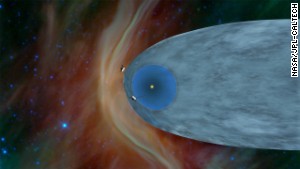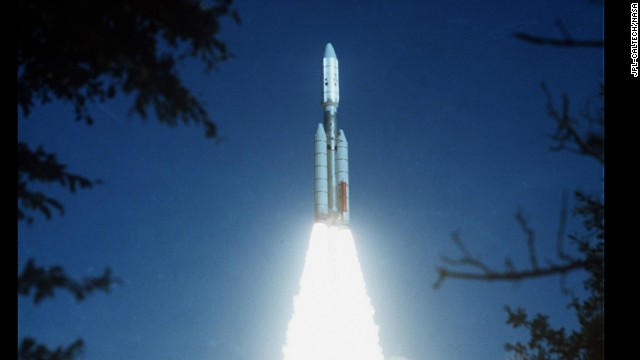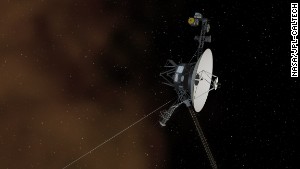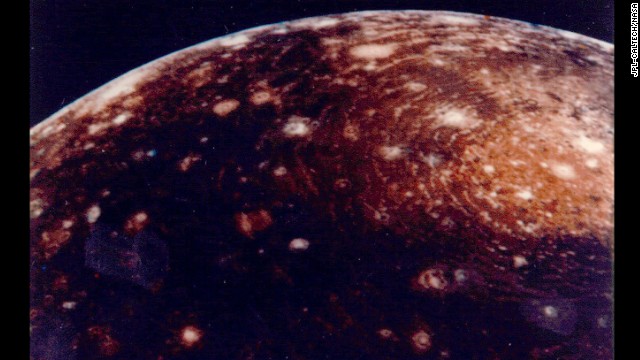Voyager 1 becomes first human-made object to leave solar system
STORY HIGHLIGHTS
- Study: Voyager 1 left heliosphere around August 25, 2012
- Voyager 1 and 2 were launched in 1977, 16 days apart
- Voyager 1 is now the first mission to explore interstellar space
But scientists now have strong evidence that NASA's Voyager 1
probe has crossed this important border, making history as the first
human-made object to leave the heliosphere, the magnetic boundary
separating the solar system's sun, planets and solar wind from the rest
of the galaxy.
"In leaving the
heliosphere and setting sail on the cosmic seas between the stars,
Voyager has joined other historic journeys of exploration: The first
circumnavigation of the Earth, the first steps on the Moon," said Ed
Stone, chief scientist on the Voyager mission. "That's the kind of event
this is, as we leave behind our solar bubble."
A new study in the journal Science
suggests that the probe entered the interstellar medium around August
25, 2012. You may have heard other reports that Voyager 1 has made the
historic crossing before, but Thursday was the first time NASA announced
it.
 NASA: Voyager 1 has left solar system
NASA: Voyager 1 has left solar system
 Images from Voyager 2
Images from Voyager 2
The twin spacecraft Voyager 1 and 2 were launched in 1977, 16 days apart. As of Thursday, according to NASA's real-time odometer,
Voyager 1 is 18.8 billion kilometers (11.7 billion miles) from Earth.
Its sibling, Voyager 2, is 15.3 billion (9.5 billion) kilometers from
our planet.
Voyager 1 is being hailed
as the first probe to leave the solar system. But under a stricter
definition of "solar system," which includes the distant comets that
orbit the sun, we'd have to wait another 30,000 years for it to get that
far, Stone said.
Another milestone for long after we're gone: The probe will fly near a star in about 40,000 years, Stone said.
How do we know?
Voyager, currently
traveling at more than 38,000 miles per hour, never sent a postcard
saying "Greetings from interstellar space!" So whether it has made the
historic crossing or not is a matter of controversy.
"The spacecraft itself
really doesn't know," Stone said. "It's only instruments that can tell
us whether we're inside or outside."
Further complicating
matters, the device aboard Voyager 1 that measures plasma -- a state of
matter with charged particles -- broke in 1980.
To get around that,
scientists detected waves in the plasma around the spacecraft and used
that information to calculate density. Vibrations in the plasma came
from a large coronal mass ejection from the sun in 2012, resulting in
what Stone called a "solar wind tsunami." These vibrations reached the
area around Voyager this spring.
Measurements taken
between April 9 and May 22 of this year show that Voyager 1 was, at that
time, located in an area with an electron density of about 0.08 per
cubic centimeter.

This illustration shows NASA's Voyager 1 spacecraft entering the space between stars.
In the interstellar
medium, the density of electrons is thought to be between 0.05 and 0.22
per cubic centimeter. The particles of interstellar plasma were created
by the explosions of giant stars, and carry the magnetic field of the
galaxy, scientists said.
Last year, between
October 23 and November 27, researchers calculate that Voyager 1 was in
an area with an electron density of 0.06 per cubic centimeter. That's
still within the interstellar space range, and it means that over time
the spacecraft passed through plasma with increasing electron density.
The study, led by
University of Iowa physicist Donald Gurnett, suggests that the plasma
density is about 30 times higher in the interstellar medium than in the
heliosphere, which is close to what scientists thought based on other
kinds of measurements. The boundary is called the heliopause.
When did it happen?
Scientists have been
using several kinds of measurements to figure out if and when Voyager 1
had reached the interstellar medium.
Evidence from particle
data had already pointed toward the conclusion that the probe succeeded.
In late July and early August of 2012, scientists saw dips in the
concentration of particles made in the solar system, and peaks in
particles made outside.
"If you just looked at
that data, you'd think it's pretty clear that we've actually crossed a
boundary. We're no longer in the place where the solar system particles
are being made, and we're actually out in the interstellar medium," said
Marc Swisdak, associate research scientist in the Institute for
Research in Electronics and Applied Physics at the University of
Maryland. Swisdak was not involved in the new study, but has worked with
Voyager data.
Magnetic field
measurements suggested otherwise. Researchers had expected to see stark
changes in magnetic field direction when the probe crossed out of the
heliosphere, but that wasn't supported by measurements from the probe.
Swisdak and colleagues
published a modeling study suggesting that the particle data is more
relevant, and that the magnetic field might not change as much as people
thought. They proposed a crossing-over date of July 27 -- about a month
sooner than the new study.
The specific date will
likely be debated for some time, Swisdak said. One possible explanation
is that if the heliosphere is analogous to an air-conditioned room,
Voyager stepped through the doorway into a hot room on July 27. For a
month it was in a metaphorical room with a mixture of hot and cold air,
and finally entered the truly hot part on August 25.
Puzzles still surround
the magnetic field at the edge of the heliosphere, Stone said, and
"We're going to be prepared to have more surprises."
What else is out there?
Voyager 1 has only 68 KB
of memory on board -- far less than a smartphone, said Suzanne Dodd,
Voyager project manager. Scientists communicate with the spacecraft
every day.
"It's the little spacecraft that could," she said in a NASA press conference.
The probe now has a totally new mission, Stone said.
"We're now on the first
mission to explore interstellar space," he said. "We will now look and
learn in detail how the wind which is outside, that came from these
other stars, is deflected around the heliosphere."
Wind -- made of
particles -- from these other stars has to go around the heliosphere the
way a water in a stream flows around a rock, Stone said. Scientists are
interested in learning more about the interaction between our solar
wind and wind from other stars.
Natural radioactive
decay provides heat that generates enough electricity to help Voyager 1
communicate with Earth. The first science instrument will be turned off
in 2020, and the last one will be shut down in 2025, Stone said.
Both Voyager probes carry time capsules known as "the golden record,"
a 12-inch, gold-plated copper disc with images and sounds so that
extraterrestrials could learn about us. Let's hope they can build
appropriate record players.
Voyager 2 will likely leave the heliosphere in about three to four years, Stone said.
Its plasma instrument is
still working, Stone said, so scientists can directly measure the
stellar wind's density, speed and temperature. That also means that when
it crosses out of the heliosphere, Voyager 2 will send a clearer
signal.
At that time, it will join its twin in the vast nothingness between stars that used to be beyond our reach.
Follow Elizabeth Landau on Twitter at @lizlandau and on Google+.

 This image of
Jupiter's moon Callisto was captured from a distance of 350,000
kilometers. The large "bull's-eye" at the top of the image is believed
to be an impact basin formed early in Callisto's history. The bright
center of the basin is about 600 kilometers across and the outer ring is
about 2,600 kilometers across.
This image of
Jupiter's moon Callisto was captured from a distance of 350,000
kilometers. The large "bull's-eye" at the top of the image is believed
to be an impact basin formed early in Callisto's history. The bright
center of the basin is about 600 kilometers across and the outer ring is
about 2,600 kilometers across.
ไม่มีความคิดเห็น:
แสดงความคิดเห็น